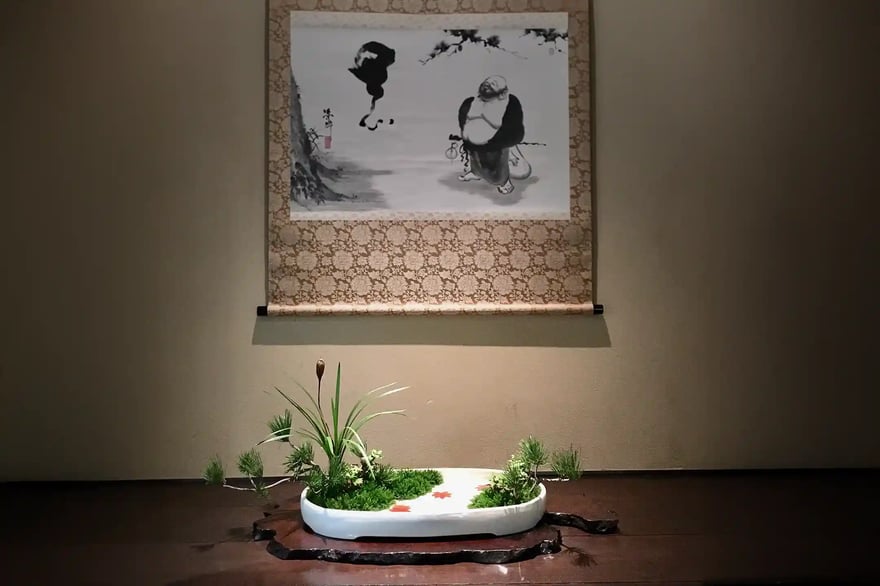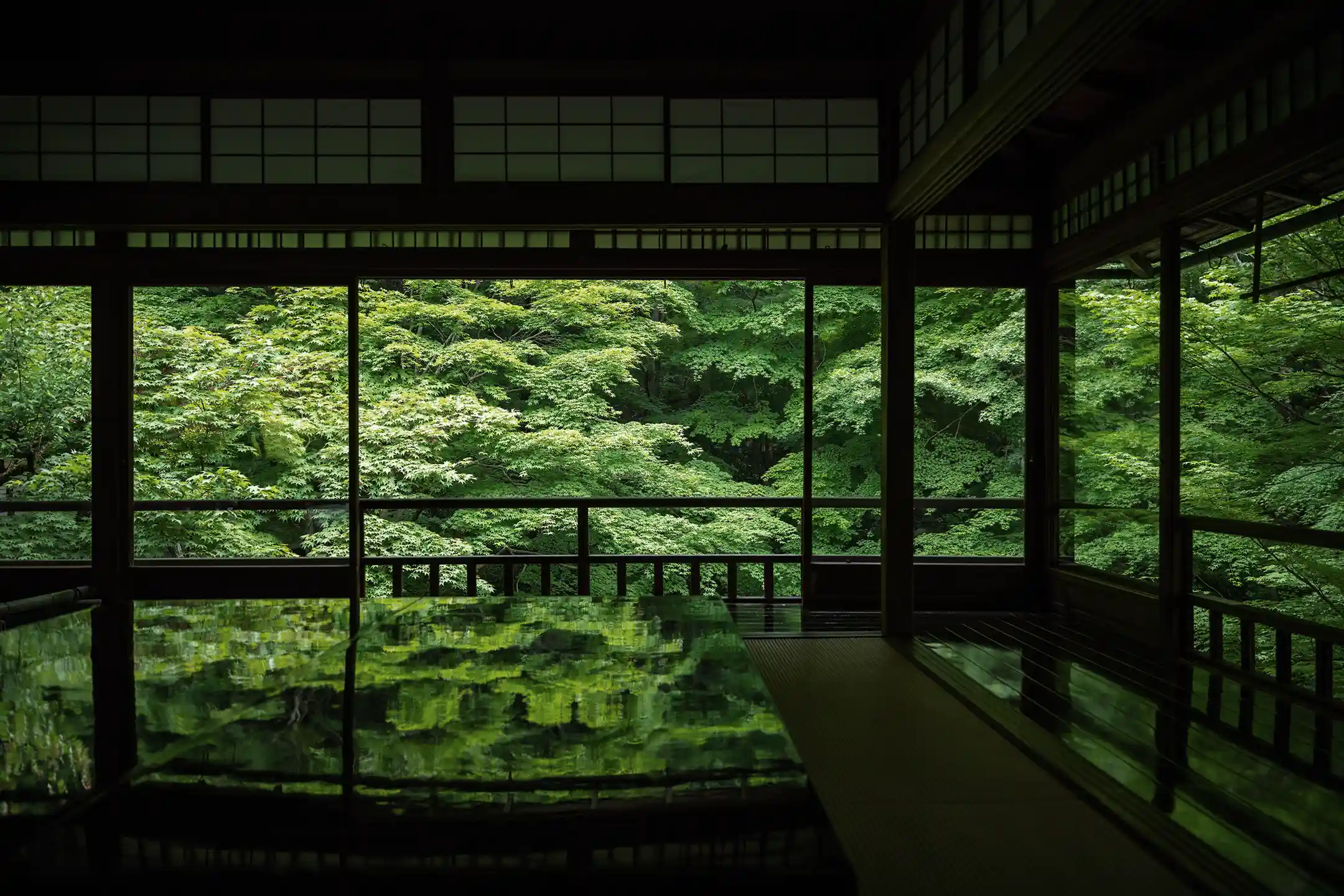In Japan, Ikebana is the traditional art of arranging flowers. Unlike Western floral designs, which often overwhelm the eye with color and volume, Ikebana entrusts its story to the "empty space." Each time a single bloom is placed gently, you shift from simply observing to truly feeling, breathing in sync with the flowers. This participatory aesthetic has long been connected with a uniquely Japanese spirituality.
In this article, we'll explore Ikebana's aesthetics, history, ways to experience it, and its ties to sustainability from multiple angles. Join us on a journey that feels like traveling through the subtle spaces between cultures.
The Aesthetics and Philosophy of Ikebana: Flower Art Imbued with Spirituality
If Western floral arrangements excite emotions with "luxury," "symmetry," and "color harmony," Ikebana calms the mind with "ma" (space), "asymmetry," and "silence." The "invisible lines" that extend beyond the vase engage your imagination, revealing that your own creativity is part of the artwork.
Furthermore, treating nature not as a "background" but as a "conversation partner" stands in stark contrast to modern views of nature as something to control. By embracing this outlook, arranging flowers becomes an exercise in placing your own perspective into context and cultivating respect for diverse worldviews (*1).

The Influence of Zen Thought on Ikebana and Its Aesthetic Significance
During the Muromachi period, Zen Buddhism—with its aesthetics of asymmetry and the concept of yūgen (profound elegance and mystery)—deeply influenced Ikebana. Forms expressing "Zen qualities" spread across many art forms. The classic composition of three branches representing the three elements (Heaven, Earth, and Humanity – Ten, Chi, and Jin in Japanese) stands in contrast to the Western theatrical idea of a single "center stage."
As a viewer, you come to realize that unspoken stories lie hidden in the empty spaces, experiencing "self," "flower," and "air" as one continuous flow. Even the act of choosing a branch is like a meditation that pares down your thoughts — a kind of "breathing philosophy" (*2).
Ikebana as Spatial Design — Fusion with Refined Interiors
In contrast to Western decor, where a modern-classic home might have a central table overflowing with large lilies, Ikebana brings a living space to life with a quiet statement. At the Sogetsu Kaikan headquarters building, the concept of treating the architecture itself as part of the arrangement reveals that the boundary between people and the environment is fluid. Even in your own living room, by limiting the color palette and emphasizing vertical lines through the natural flow of branches, you can create the sensation of a seasonal breeze blowing through your home (*3)(*4).

Origins and History of Ikebana: How Did This Traditional Japanese Art Develop?
_Bijin_hana_kurabe_(serietitel_op_object)%2c_RP-P-1982-102.webp?width=880&height=587&name=Ikebana_tentoonstelling_Vergelijkingen_tussen_schoonheden_en_bloemen_(serietitel)_Bijin_hana_kurabe_(serietitel_op_object)%2c_RP-P-1982-102.webp)
Ikebana began as floral offerings at Buddhist altars, a rare example of transforming flowers from "offerings to the divine" into "expressions of the human inner landscape." During the Momoyama period, when samurai culture was at its peak, the Ikenobo school depicted a cosmos using seven branches, creating a setting where people from different social classes could appreciate the same flowers.
In the Taisho era, the Sogetsu and Ohara schools introduced Western flowers and free-form lines, effortlessly bridging the divide between "traditional" and "modern" and accelerating a global artistic dialogue (*1).
The Major Schools of Ikebana – Characteristics of Ikenobo, Sogetsu, and Ohara
Ikenobo: Originating from Buddhist rituals, this style uses a vertical arrangement uniting Heaven, Earth, and Humanity to illustrate the idea that "the world is large and people are small" (*1).
Sogetsu: Established in 1927 under the credo that "anyone, anywhere, with anything" can create Ikebana. It embraces non-floral materials like metal or plastic on par with flowers, blurring the boundary between "center" and "periphery" (*2).
Ohara: By using a shallow vase (suiban) as a horizontal mirror to reflect the sky or interior, this style presents flowers as part of the scenery. This naturalistic approach invites the viewer to shift from being a "spectator" to a "co-creator" (*3).
Tracing Ikebana's History: Recommended Museums & Sites Across Japan
Ikebana History Museum (Kyoto): Displays historical materials, flower containers, and artifacts related to the Ikenobo school, allowing you to immerse yourself in the world of Ikebana and its cultural background (*4).
Sogetsu Kaikan (Tokyo): Showcases Isamu Noguchi's stone garden Tengoku (Heaven) alongside improvisational flower displays, creating a place where "native" and "foreign" elements resonate in harmony.
MOA Museum of Art (Shizuoka): Offers an Ikebana arrangement experience in kimono as part of its "Japanese Culture Experience" program, letting visitors try arranging flowers in traditional attire.
Experiencing Ikebana in Japan: Cultural Lessons to Refine Your Senses and Mind
If you're ready to move from simply "seeing" to actively "creating," consider adding an Ikebana lesson to your itinerary. In beginner-friendly classes offered in English, you'll discover that even the act of opening or closing the scissors carries meaning—an insight showing that even the tools are part of the culture. You may be surprised to learn how, in Ikebana, the process actually begins with carefully choosing your own materials.
Learning from a Master: The Benefits and Insights of a Special Ikebana Lesson
At the Sogetsu Headquarters' international classes, instructors carefully listen to each participant's intentions and teach the mindset that "regardless of the creator's origin or gender, one should respect the voice the flowers express." When you bring your finished arrangement home, one of the joys is rediscovering how your own "cultural perspective" is reflected in the piece (*1).
Savoring Japan's Four Seasons: Ikebana Experience with Seasonal Materials
In a machiya (traditional townhouse) studio in Kyoto, seasonal branches are sent directly from the market. When local growers and global travelers connect through flowers, it creates a true "mutual understanding" made visible. Through a market tour, you'll also become aware of issues like logistics, labor, and the impacts of climate change, turning your trip into a hands-on fieldwork learning experience (*2)(*3).
Ikebana in Pursuit of Sustainability: A Traditional Art in Harmony with the Environment

The design concept of "fewer flowers, more space" not only reduces the consumption of plant materials but also teaches us the ethic of "knowing when enough is enough." For those accustomed to mass production and consumption, realizing that "even a single flower can express an entire world" offers a chance to rethink our values. Reusing the kenzan (needle-point flower holder) or choosing ethically-sourced flowers are great examples of how art can be a hands-on tool for social learning (*1).
Ikebana for Sustainable Beauty: Ethical Flowers and Environmental Initiatives
International research suggests that empathy for plants cultivated through Ikebana broadens one's "imagination for others." The Sogetsu school's composting project highlights how flowers "return to the earth" after display, reinforcing the sense that "every ending is the beginning of a cycle" (*2).
An Ikebana-Inspired Journey: Eco-Friendly Facilities and Green Transportation
In late 2021, Kyoto debuted a fully electric bus loop line that "runs quietly," its silence resonating with the serene sight of machiya townhouses outside and gently slowing the pace of your journey (*3). Meanwhile, JR East is working to reduce the environmental footprint of its trains as part of an initiative to achieve "carbon neutrality by 2050" (*4). These initiatives reflect how even Japan's modern infrastructure can echo Ikebana's ethos of harmony with the environment.
Finally
Ikebana distills perspectives on nature, philosophy, and environmental ethics into the simple act of arranging a flower, turning it into a mirror that reflects your own values. For those of you from the West, with its rich decorative traditions, the quiet act of arranging a single bloom offers a chance to discover another cultural possibility. On your next trip to Japan, be sure to set aside a moment to find harmony with flowers, and take home a new perspective that celebrates differences as your souvenir.
Author Bio





